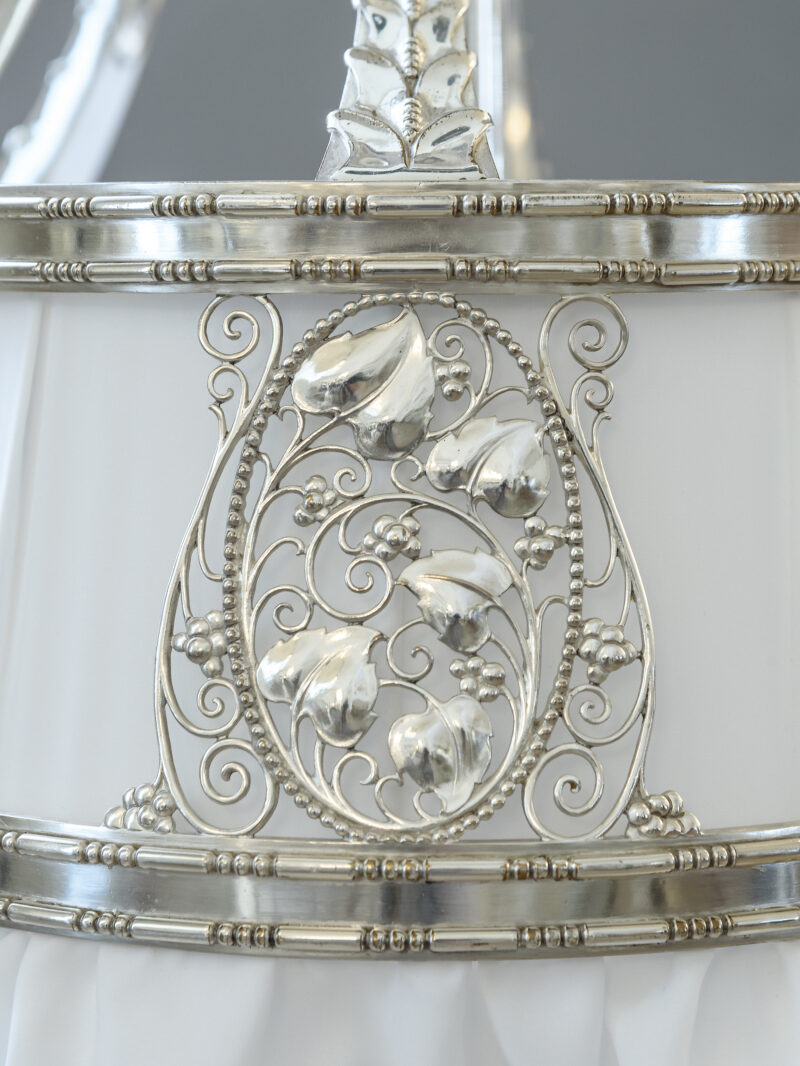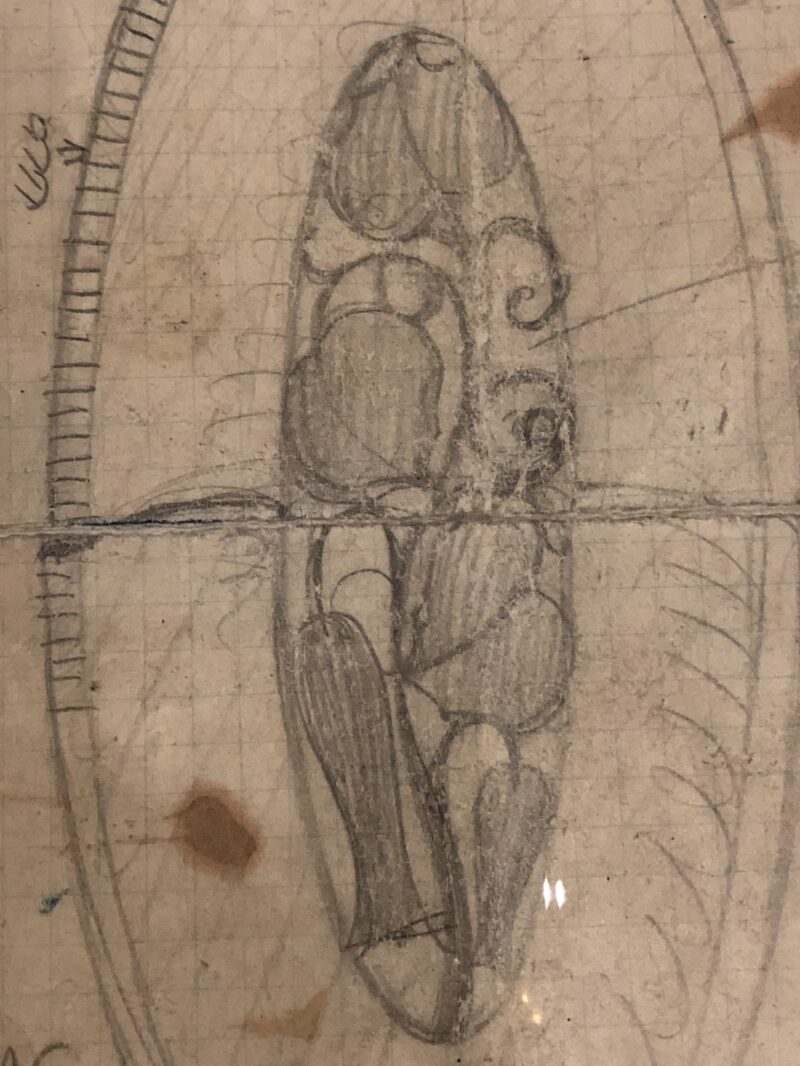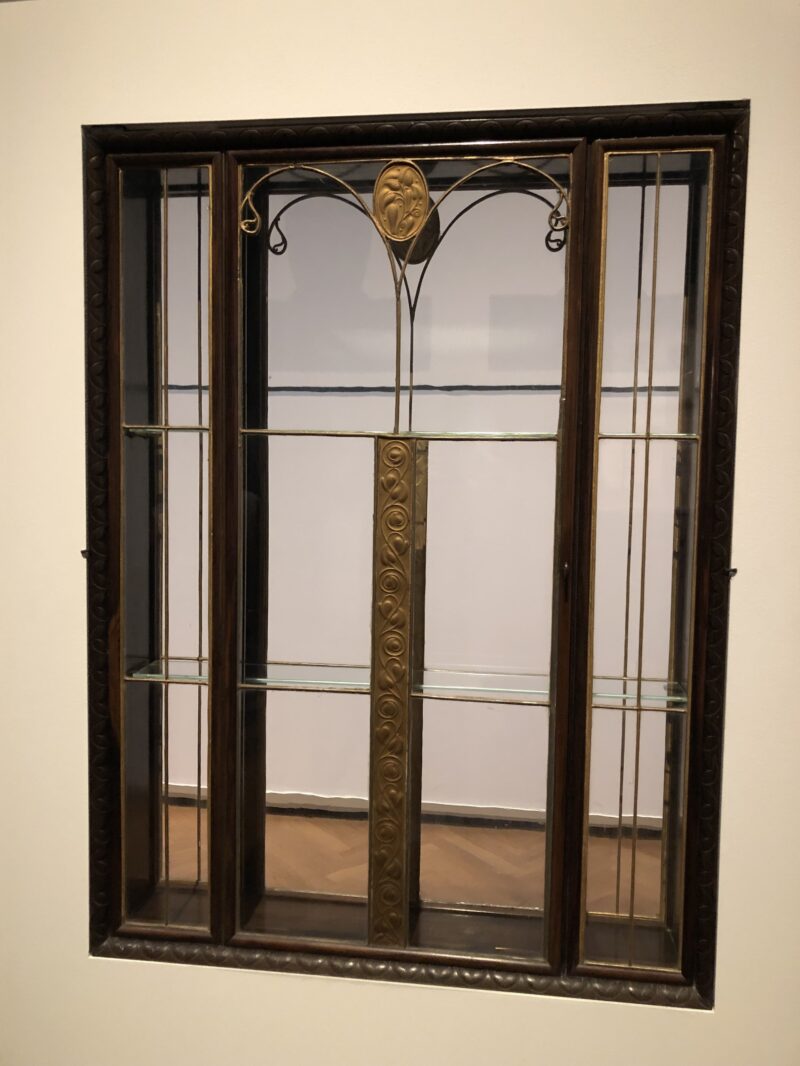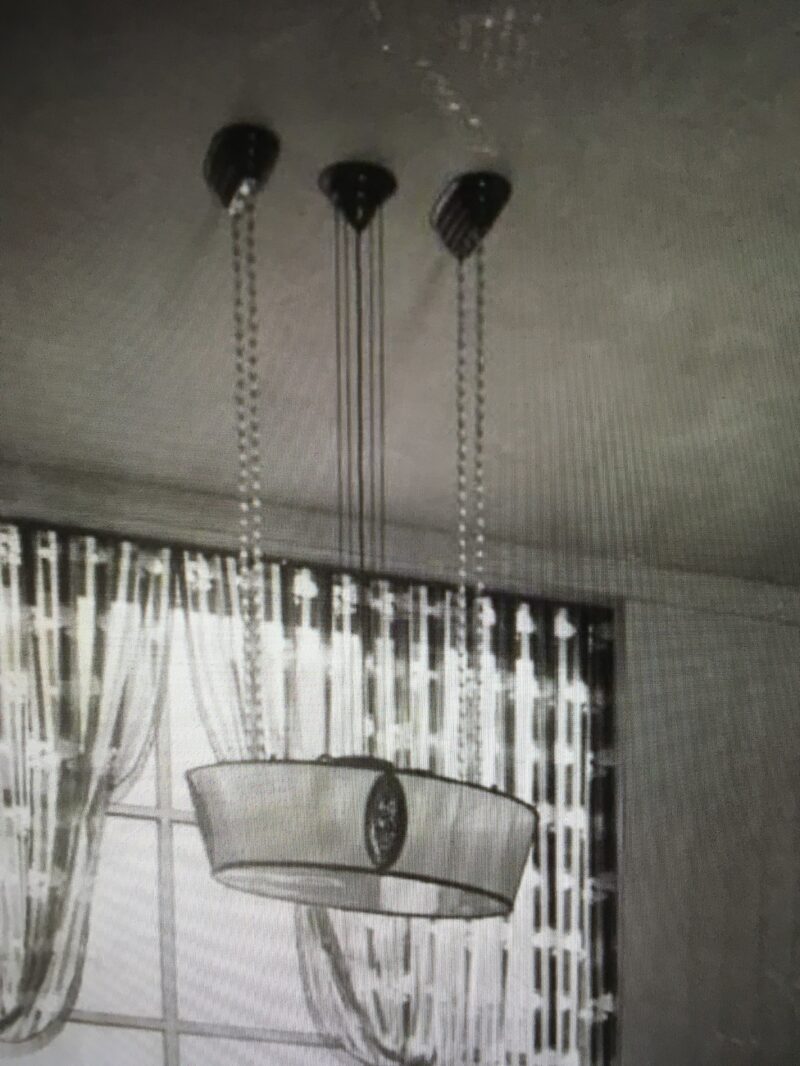
Viennese Ceiling Light around 1910
This stunning Chandelier is crafted in a beautifully silver-plated design and has nine arms in total, with five light bulbs inside the chandelier shade and four on the oval, black-polished ceiling plate.
The fine chandelier crown is decorated with six medallion-shaped elements, each featuring the frequently used Hoffmann motif of heart-shaped leaves with vines and fruits, and surrounded by a pearl rod between two bands. Above them are four slightly tapered struts, which connect to the central bowl and are decorated with the leaves and berries of the holly plant.
The closed central bowl is also decorated multiple times around the perimeter with pearl edges, holly leaves, and berries. The silver-plated chandelier stem is crowned by an equally decorated cover plate. Above this cover plate is the oval black shellacked ceiling plate, on which four silver-plated lamp sockets decorated with pearl rods are mounted. This idea of room lighting, which could be switched separately from the chandelier, can be considered an early version of today’s ceiling spotlights.The silver-plated chandelier has been restored with great care in our workshops, a new silk shade has been handcrafted, and it has been newly electrified and equipped with the original silver-plated sockets with long porcelain necks. Many of the ornaments used in this design are found more frequently in the designs of Josef Hoffmann. Hoffmann often used the heart-shaped leaf motif in his brooch designs. The ornamentation of the cover plates with pearl edges can also be found in Josef Hoffmann’s designs for his silver and centerpiece bowls.
In view of its truly extraordinary design, as well as its absolutely fine and detailed execution, this chandelier can be seen as a perfect example of the fantastically beautiful quality of the art and interior objects created in the context of the Wiener Werkstätte. We show you comparable designs from the collection of the Museum of Applied Arts (MAK), as well as detail shots from furniture designs below.
A significant design of a chandelier by Josef Hoffmann, which was executed by Ludwig Lobmeyr, is the Cologne chandelier, designed for the Werkbund Exhibition 1914, which can still be seen today on permanent loan from the family at the MAK in Vienna. In contrast to the present chandelier, the heart-shaped leaf ornaments in the chandelier crown of the Cologne chandelier are worked in hammered finish, which gives them a less delicate appearance. With the silver-plated execution and the delicacy of the work of the present chandelier, there is no doubt that it was definitely a commissioned work for a wealthy client. It is a rare unique piece and a masterpiece from one of the most significant and interesting stylistic periods in Vienna. This modern design with the idea of separately illuminated ceiling sockets is also considered a precursor to today’s ceiling spotlights.
All of this is wonderful evidence of the high-quality materials used during the time of the Wiener Werkstätte, as well as the pioneering role of significant architects and designers on the way to modernity.
Josef Hoffmann (1870−1956):
Josef Hoffmann was born in 1870 in Pirnitz/Moravia during a socially and politically difficult time, but it was also the beginning of the Industrial Revolution with all its positive and negative aspects. In 1892, Josef Hoffmann began his architecture studies at the Academy of Fine Arts in Vienna under Carl von Hasenauer and Otto Wagner. He was early on fascinated by the English-Scottish Arts and Crafts movement, whose vision was to fill all areas of life with art, design everyday and utilitarian objects in a more beautiful and aesthetic way, and make artfully designed objects accessible to a broader social class. J. Hoffmann, as well as his teacher Otto Wagner, believed that art could even have a healing effect on the human soul. They believed that the role of the architect should be much larger, that the architect should also be a designer, and that all objects to be used should be redesigned. Hoffmann remained true to this credo throughout his life. At the young age of just 29, Hoffmann was already appointed professor at the University of Applied Arts in Vienna. This was followed by one of the significant steps in Hoffmann’s career, after he joined the “Vienna Secession” in 1897 with Gustav Klimt, Koloman Moser, Joseph Maria Olbrich, Carl Moll, and others. This association saw itself as a counter-movement to the established artists. Only six years later, he founded the Wiener Werkstätte together with Koloman Moser and with the support of industrialist Fritz Waerndorfer in 1903. The Sanatorium Purkersdorf, implemented in 1904, must be counted among the first eight iconic masterpieces of Hoffmann, in which he designed everything down to the smallest detail, from the interior to the gardens. This overall work of art set almost radical new standards in the view of architecture and design. One of Josef Hoffmann’s most significant works, which ultimately brought him international breakthrough, was the Stoclet Palace in Brussels. In this building, which he realized between 1905 and 1911, he was able to fully realize his vision of a total work of art. Architecture and design merge with daily life, and art becomes an aesthetic part of our everyday life. An interesting aspect of the idea of a total work of art would be that the important Danish-Austrian master builder and architect of Classicism and Historicism, Theophil Edvard Hansen (1813 in Copenhagen — 1891 in Vienna), had the vision of a total work of art of building and furnishing and was also able to implement it in some of his projects in Vienna. The strict and clear design language of Hoffmann’s designs paved the way for modernism and, like Adolf Loos’s designs, are works of timeless elegance, made with the highest possible quality and execution. An important quote from Le Corbusier about Josef Hoffmann might be: “Today, when the new generations…take ownership of the fruits of the work of the true pioneers, it is only fair…to express our gratitude to men like Professor Hoffmann and to companies as bold as the Wiener Werkstätte. Finally, what remains is the indispensable superfluous, art.”
S. MAK Exhibition in Vienna: JOSEF HOFFMANN. Progress Through Beauty
See images below, Literature: MAK Exhibiton: Wall Vitrine from the staircase of Villa Ast, 1910; execution Wiener Werkstätte, Macassar-ebony, brass.
THE OTTO SCHOENTHAL COLLECTION image at the bottom: Josef Hoffmann 1870 – 1956, Progress Through Beauty, MAK p. 187 dep. 3 JH, Herrenzimmer (Gentleman Room) of Prof. Dr. Otto Zuckerkandl’s apartment, 1912⁄13













